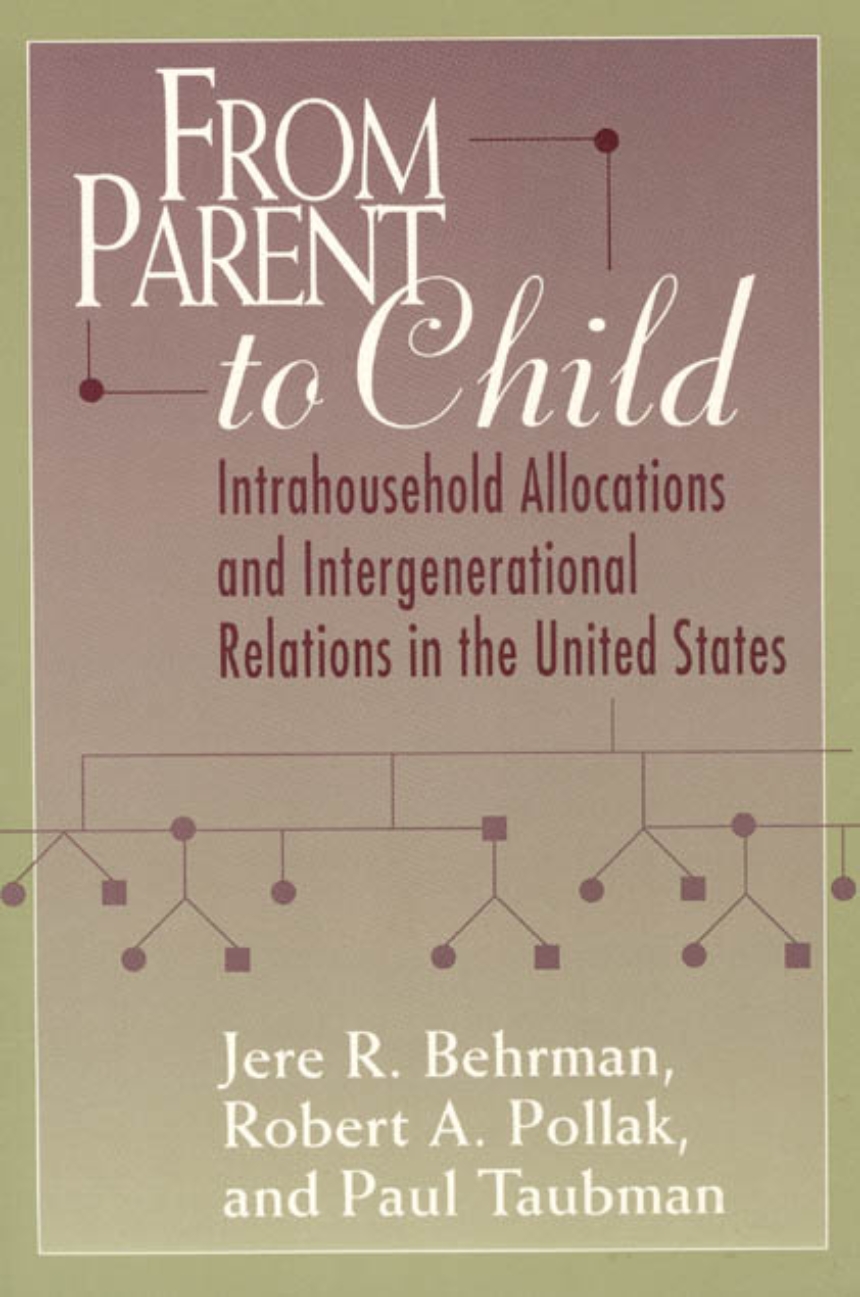From Parent to Child
Intrahousehold Allocations and Intergenerational Relations in the United States
9780226041575
9780226041568
From Parent to Child
Intrahousehold Allocations and Intergenerational Relations in the United States
How do parents allocate human capital among their children? To what extent do parental decisions about resource allocation determine children’s eventual economic success?
The analyses in From Parent to Child explore these questions by developing and testing a model in which the earnings of children with different genetic endowments respond differently to investments in human capital. Behrman, Pollak, and Taubman use this model to investigate issues such as parental bias in resource allocations based on gender or birth order; the extent of intergenerational mobility in income, earnings, and schooling in the United States; the relative importance of environmental and genetic factors in determining variations in schooling; and whether parents’ distributions offset the intended effects of government programs designed to subsidize children. In allocating scarce resources, parents face a trade-off between equity and efficiency, between the competing desires to equalize the wealth of their children and to maximize the sum of their earnings.
Building on the seminal work of Gary Becker, From Parent to Child integrates careful modeling of household behavior with systematic empirical testing, and will appeal to anyone interested in the economics of the family.
The analyses in From Parent to Child explore these questions by developing and testing a model in which the earnings of children with different genetic endowments respond differently to investments in human capital. Behrman, Pollak, and Taubman use this model to investigate issues such as parental bias in resource allocations based on gender or birth order; the extent of intergenerational mobility in income, earnings, and schooling in the United States; the relative importance of environmental and genetic factors in determining variations in schooling; and whether parents’ distributions offset the intended effects of government programs designed to subsidize children. In allocating scarce resources, parents face a trade-off between equity and efficiency, between the competing desires to equalize the wealth of their children and to maximize the sum of their earnings.
Building on the seminal work of Gary Becker, From Parent to Child integrates careful modeling of household behavior with systematic empirical testing, and will appeal to anyone interested in the economics of the family.
322 pages | 20 line drawings, 36 tables | 6 x 9 | © 1995
Population and Development Series
Economics and Business: Economics--Development, Growth, Planning
Table of Contents
Introduction
1: Parental Preferences and Provision for Progeny
Jere R. Behrman, Robert A. Pollak, Paul Taubman.
2: Family Resources, Family Size, and Access to Financing for College Education
Jere R. Behrman, Robert A. Pollak, Paul Taubman.
3: Do Parents Favor Boys?
Jere R. Behrman, Robert A. Pollak, Paul Taubman.
4: Birth Order, Schooling, and Earnings
Jere R. Behrman, Paul Taubman.
5: The Wealth Model: Efficiency in Education and Distribution in the Family
Jere R. Behrman, Robert A. Pollak, Paul Taubman.
6: A Transaction Cost Approach to Families and Households
Robert A. Pollak
7: Tied Transfers and Paternalistic Preferences
Robert A. Pollak
8: Is Child Schooling a Poor Proxy for Child Quality?
Jere R. Behrman
9: Schooling and Other Human Capital Investments: Can the Effects Be Identified?
Jere R. Behrman
10: Intergenerational Earnings Mobility in the United States: Some Estimates and a Test of Becker’s Intergenerational Endowments Model
Jere R. Behrman, Paul Taubman.
11: The Intergenerational Correlation between Children’s Adult Earnings and Their Parents’ Income: Results from the Michigan Panel Survey of Income Dynamics
Jere R. Behrman, Paul Taubman.
12: On Heritability
Paul Taubman
13: Is Schooling "Mostly in the Genes"? Nature-Nurture Decomposition Using Data on Relatives
Jere R. Behrman, Paul Taubman.
14: Measuring the Impact of Environmental Policies on the Level and Distribution of Earnings
Paul Taubman
References
Author Index
Subject Index
1: Parental Preferences and Provision for Progeny
Jere R. Behrman, Robert A. Pollak, Paul Taubman.
2: Family Resources, Family Size, and Access to Financing for College Education
Jere R. Behrman, Robert A. Pollak, Paul Taubman.
3: Do Parents Favor Boys?
Jere R. Behrman, Robert A. Pollak, Paul Taubman.
4: Birth Order, Schooling, and Earnings
Jere R. Behrman, Paul Taubman.
5: The Wealth Model: Efficiency in Education and Distribution in the Family
Jere R. Behrman, Robert A. Pollak, Paul Taubman.
6: A Transaction Cost Approach to Families and Households
Robert A. Pollak
7: Tied Transfers and Paternalistic Preferences
Robert A. Pollak
8: Is Child Schooling a Poor Proxy for Child Quality?
Jere R. Behrman
9: Schooling and Other Human Capital Investments: Can the Effects Be Identified?
Jere R. Behrman
10: Intergenerational Earnings Mobility in the United States: Some Estimates and a Test of Becker’s Intergenerational Endowments Model
Jere R. Behrman, Paul Taubman.
11: The Intergenerational Correlation between Children’s Adult Earnings and Their Parents’ Income: Results from the Michigan Panel Survey of Income Dynamics
Jere R. Behrman, Paul Taubman.
12: On Heritability
Paul Taubman
13: Is Schooling "Mostly in the Genes"? Nature-Nurture Decomposition Using Data on Relatives
Jere R. Behrman, Paul Taubman.
14: Measuring the Impact of Environmental Policies on the Level and Distribution of Earnings
Paul Taubman
References
Author Index
Subject Index
